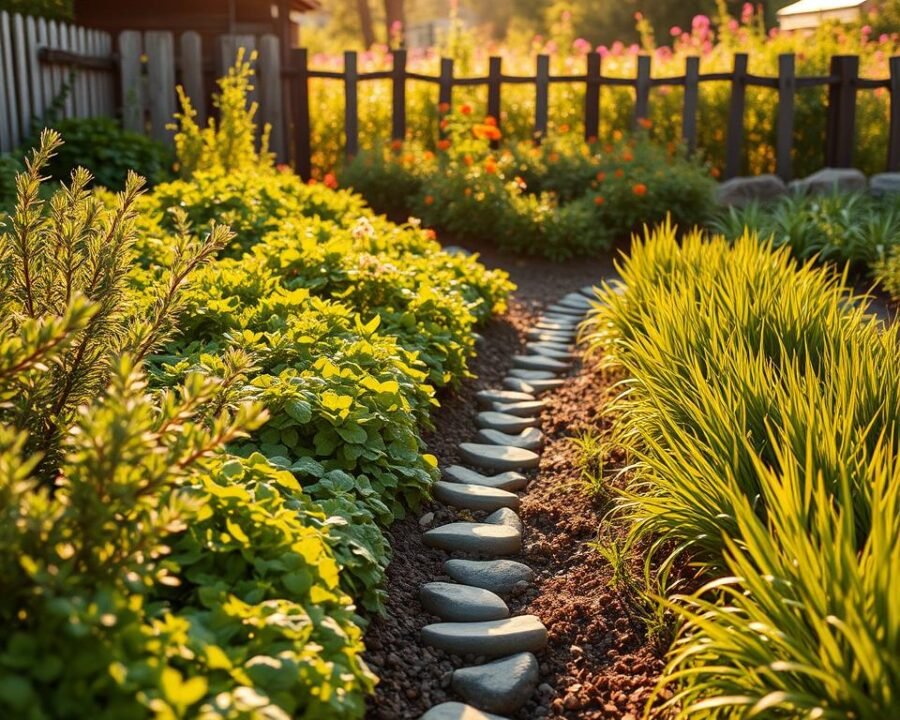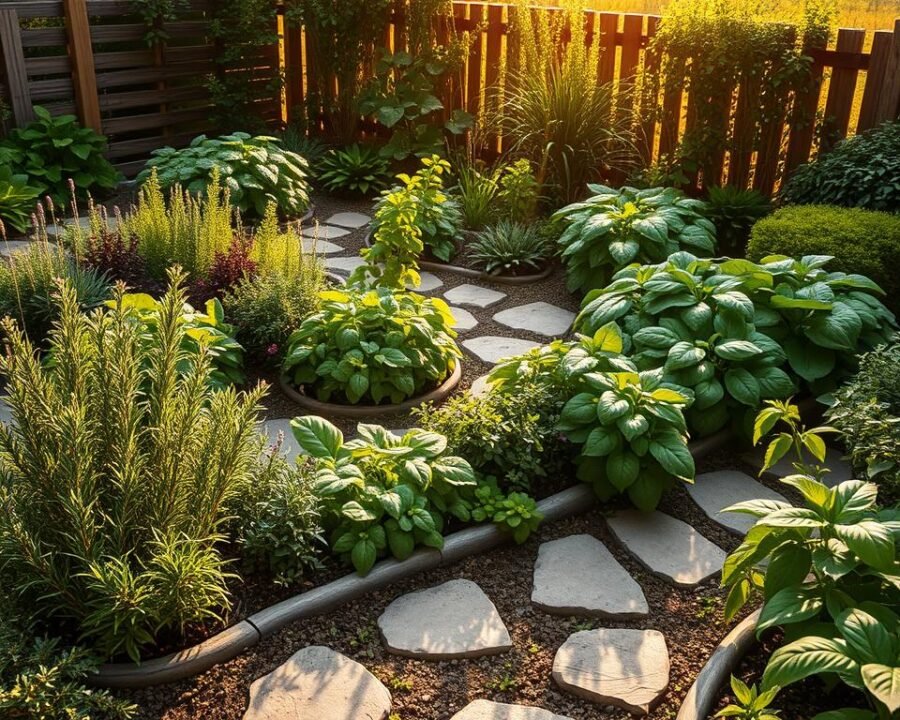Learn How to Grow What Herbs Can I Plant Together Everyone Is Using
There’s something magical about stepping into a lush, fragrant herb garden. The vibrant greens, the earthy scents—it’s a space where nature and flavor unite. But did you know some herbs thrive better when planted near certain companions? The right pairings can enhance growth, deter pests, and even improve taste.
Companion planting isn’t just a trend; it’s a time-tested method to maximize your garden’s potential. Whether you’re a seasoned gardener or just starting, understanding which herbs work well together can transform your outdoor space. From boosting yields to creating natural pest barriers, smart pairings make all the difference.
In this guide, we’ll explore the best combinations for a flourishing, aromatic garden. Discover how sunlight, soil needs, and growth habits influence success. Let’s dive into the secrets of harmonious planting!
Key Takeaways
- Companion planting enhances herb growth and flavor.
- Proper pairings help deter pests naturally.
- Sunlight and soil compatibility are crucial for success.
- Strategic layouts save space and boost productivity.
- Some herbs thrive together, while others compete.
Introduction to Companion Planting for Herbs
Nature thrives on partnerships, and herbs are no exception. Pairing the right plants creates a symbiotic relationship, where each supports the other’s growth. This method, called companion planting, turns a simple garden into a resilient, flavorful oasis.
Why Planting Herbs Together Matters
Certain herbs naturally enhance each other’s vitality. For example, basil and tomatoes share nutrients, while rosemary deters pests. These partnerships reduce the need for chemicals, making your garden eco-friendly.
Space efficiency is another perk. Compact herbs like thyme thrive alongside larger plants, maximizing every inch. Plus, diverse aromas confuse pests, protecting your harvest.
Benefits of Herb Companion Planting
Natural pest control: Strong-scented herbs like lavender repel insects. This creates a healthier environment for herbs grow without sprays.
Flavor enhancement: Basil near peppers intensifies their taste. Strategic placement elevates culinary results.
Soil health: Deep-rooted herbs like dill loosen soil, benefiting shallow-rooted neighbors. Balanced ecosystems thrive.
How to Grow What Herbs Can I Plant Together Everyone Is Using
Pairing herbs strategically unlocks their full potential. The right combinations boost growth, flavor, and resilience. Let’s explore the essentials for harmony in your garden.
Key Factors for Successful Herb Pairings
Sunlight needs: Group full-sun lovers like rosemary separately from shade-preferring mint. Mismatched light requirements stunt growth.
Water alignment: Drought-tolerant thyme clashes with moisture-loving basil. Keep soil needs consistent to avoid root stress.
- Growth speed: Fast-spreading oregano can overwhelm slow-growing sage.
- Soil pH: Alkaline-loving lavender struggles near acidic-soil fans like parsley.
Popular Herb Combinations for Beginners
Start simple with this foolproof trio:
Basil, parsley, and chives share similar light and water needs. Their roots occupy different depths, minimizing competition.
For pest control, pair rosemary with sage. Their aromatic oils repel insects naturally. Remember: compatibility ensures a thriving, low-maintenance garden.
Best Herbs to Plant Together for a Thriving Garden
A thriving herb garden starts with perfect pairings. Some combinations enhance flavor, while others fend off pests or save space. Let’s explore the top teams for a lush, productive garden.
Mediterranean Herbs: Rosemary, Thyme, and Sage
These sun-loving, drought-tolerant herbs are a match made in heaven. Rosemary and thyme share similar soil needs—well-drained and slightly sandy. Sage complements them by repelling cabbage moths.
Tips for success:
- Plant in full sun (6+ hours daily).
- Water sparingly—overwatering causes root rot.
- Prune regularly to encourage bushier growth.
Fresh and Flavorful: Basil, Parsley, and Cilantro
This trio thrives in moist, fertile soil. Basil boosts nearby plants’ flavor, while parsley attracts beneficial insects. Cilantro bolts in heat, so harvest it early.
Care instructions:
- Keep soil consistently damp.
- Use mulch to retain moisture.
- Pair with tomatoes for a garden powerhouse.
Mint Family: Lemon Balm and Peppermint
Warning: these spread aggressively! Plant mint and lemon balm in containers to curb their takeover. Their strong scents deter pests like ants and aphids.
Containment strategies:
- Use pots with drainage holes.
- Trim stems regularly to control growth.
- Place near pathways for easy harvesting.
Herbs That Should Never Be Planted Together
Not all herbs play nicely in the garden—some clash like rival siblings. While companion planting boosts growth, mismatched pairings can stunt or even kill nearby plants. Knowing which combinations to avoid saves time and heartache.
Competitive Herbs to Avoid Pairing
Dill stunts fennel and caraway, releasing chemicals that hinder their growth. Similarly, mint’s aggressive roots overpower delicate parsley, stealing nutrients and space.
Watch for these troublemakers:
- Fast spreaders (like lemon balm) vs. slow growers (chives).
- Deep-rooted plants (dill) competing with shallow herbs (cilantro).
Herbs with Conflicting Soil and Sun Needs
Sun lovers like rosemary wilt in shade, while mint thrives in cooler spots. Soil pH matters too—lavender’s alkaline preference clashes with acid-loving basil.
Key mismatches:
- Dry soil herbs (thyme) vs. moisture lovers (parsley).
- Nutrient hogs (oregano) starving neighbors (sage).
Plan wisely to keep your garden harmonious and productive!
Understanding Herb Growth Habits
Herbs have unique growth patterns that shape garden success. Some sprout quickly and fade in months, while others return year after year. Recognizing these differences helps create thriving plant communities.
Annual vs. Perennial Herbs: What to Know
Perennial herbs like rosemary and thyme survive winters, regrowing each spring. Annuals such as basil complete their lifecycle in one season. This affects planting strategies and space allocation.
Key considerations:
- Mix both types for continuous harvests
- Mark perennials to avoid accidental removal
- Plan succession planting for annuals
Managing Fast-Growing Herbs Like Mint
Mint spreads aggressively through underground runners. Without control, it can overtake nearby plants. Container gardening solves this while keeping flavors fresh.
Effective containment methods:
- Use pots with drainage holes
- Install buried roots barriers
- Harvest frequently to slow expansion
With proper planning, even vigorous herbs become valuable garden partners. Their growth habits can work for us, not against us.
Soil and Sunlight Requirements for Herb Companions
The secret to a flourishing herb garden lies beneath the surface—in the soil and sunlight. These elements determine whether pairings thrive or struggle. Matching conditions ensures roots absorb nutrients while leaves bask in ideal light.
Ideal Soil Conditions for Herb Pairings
Mediterranean favorites like rosemary crave alkaline, well-drained earth. Meanwhile, mint thrives in rich, moist beds. Test pH levels with a kit, and amend as needed:
- Add lime to raise pH for lavender or oregano.
- Mix compost into acidic soil for parsley or basil.
Boost drainage with perlite or sand. Mulch retains moisture for water-loving plants like cilantro without drowning drought-tolerant thyme.
Sunlight Needs: Full Sun vs. Partial Shade Herbs
Group herbs by their light preferences. Rosemary and sage demand 6+ hours of direct sun. Shade-tolerant mint or lemon balm burns in harsh afternoon rays.
Track daily patterns to identify microclimates. Use taller plants to cast dappled shade for delicate companions. This balance turns any garden into a symphony of growth.
Herb Companion Planting Chart for Quick Reference
Visual guides simplify the art of companion planting. Our chart highlights perfect pairs and combative combinations at a glance. Save time while optimizing your garden’s potential.
Compatible Herbs for Every Garden Style
Whether you prefer culinary clusters or medicinal groupings, smart layouts enhance results. Consider these proven teams:
| Garden Type | Best Combinations | Benefits |
|---|---|---|
| Culinary | Basil + Oregano + Thyme | Flavor synergy, pest resistance |
| Medicinal | Echinacea + Lemon Balm + Chamomile | Shared soil needs, pollinator attraction |
| Aromatic | Lavender + Rosemary + Sage | Drought tolerance, deer resistance |
Container tip: Pair mint with chives in pots—their root depths complement without competing. Ground planting favors sprawling herbs like oregano.
Herbs to Keep Separate
Some combinations create more struggle than synergy. Watch for these conflict zones:
- Fennel with most others—it inhibits nearby growth
- Mint near parsley (aggressive roots)
- Dill and carrots (shared pest attraction)
Seasonal adjustments matter too. Cool-weather cilantro bolts when paired with heat-loving basil. Rotate placements annually for balanced soil nutrition.
Tips for Planting Herbs in Small Spaces
Limited space doesn’t mean limited possibilities for your herb garden. With clever layouts and strategic pairings, even windowsills become productive. We’ll explore container and vertical solutions that maximize every inch.
Container Gardening for Herb Companions
Pots transform tight areas into thriving green zones. Choose containers based on root depth—shallow for chives (6″ deep), deeper for rosemary (12″+). Group herbs with matching needs:
- Mediterranean trio: Rosemary, thyme, and oregano in terracotta (drains fast).
- Moisture lovers: Basil and parsley in self-watering pots.
- Isolate mint in its own pot to prevent takeover.
“A 10-inch diameter pot fits three compact herbs like cilantro, parsley, and chives—their roots won’t compete.”
Vertical Herb Gardens: Maximizing Space
Walls and railings unlock new planting real estate. Try these setups:
| Vertical Style | Best Herbs | Key Benefit |
|---|---|---|
| Pocket planters | Thyme, creeping rosemary | Drought-tolerant; cascades beautifully |
| Tiered shelves | Basil, dill, parsley | Easy rotation for even light |
| Hanging baskets | Mint, lemon balm | Contains spreaders while saving bed space |
For DIY options, repurpose shoe organizers or pallets. Ensure south-facing spots get 6+ hours of sun. Rotate planters weekly to prevent lopsided growth.
How to Prevent Overcrowding in Your Herb Garden
A well-spaced herb garden ensures each plant thrives without competition. Overcrowding stunts growth, invites pests, and reduces flavor. With smart planning, we create harmony above and below the soil.

Spacing Guidelines for Healthy Growth
Anticipate mature sizes—rosemary spreads 3 feet wide, while chives stay compact. Label seedlings to avoid surprises. Here’s a quick reference:
- Large herbs (sage, lavender): 18–24 inches apart.
- Medium herbs (basil, thyme): 12 inches.
- Small herbs (chives, cilantro): 6 inches.
Rotate crops each year to prevent soil depletion. Fast growers like dill can follow slow starters like parsley.
Pruning and Harvesting to Maintain Balance
Regular trimming keeps aggressive herbs in check. Snip mint stems above leaf nodes to encourage bushiness. For deep-roots plants like oregano, divide clumps every 2 years.
“Harvest outer leaves first—this promotes airflow and deters mold.”
Stagger pruning sessions. Focus on one section per week to sustain continuous growth. This way, your garden remains lush and productive.
Herbs That Improve Each Other’s Flavor and Growth
Certain herbs form powerful alliances, boosting flavor and vitality in surprising ways. These partnerships go beyond basic companionship—they actively enhance each other’s essential oils, nutrient uptake, and pest resistance. When matched wisely, your garden becomes a network of mutual support.
Scientific studies confirm these synergies. Basil, for instance, increases antioxidant levels in nearby tomatoes. Similarly, rosemary’s aromatic compounds strengthen neighboring plants against fungal threats. Let’s explore the most dynamic duos.
Nutrient-Sharing Herbs Like Basil and Rosemary
Root-level teamwork makes these pairs exceptional. Basil and rosemary exchange potassium and phosphorus through soil microbes. This underground network helps both thrive in poor soils.
Key nutrient-sharing teams:
- Basil + oregano: Basil’s magnesium aids oregano’s flowering.
- Chives + parsley: Chives’ sulfur compounds boost parsley’s folate content.
- Dill + cilantro: Shared calcium uptake strengthens cell walls.
Herbs That Deter Pests Naturally
Aromatic oils do double duty—flavoring dishes and repelling invaders. Strong scents mask vulnerable plants from insects’ detection.
Top protective pairings:
- Lavender + thyme: Deters moths and slugs.
- Mint + catnip: Confuses aphids and flea beetles.
- Garlic chives + roses: Reduces black spot fungus.
For best results, interplant these throughout your garden. Their combined defenses create a resilient ecosystem.
Common Mistakes to Avoid When Planting Herbs Together
Avoiding common pitfalls ensures a healthier herb garden. While companion planting offers many benefits, small errors can disrupt harmony. We’ll highlight key missteps to keep your plant partnerships thriving.
Overwatering or Underwatering Companion Herbs
Mediterranean herbs like rosemary need dry soil, while basil prefers consistent moisture. Pairing them leads to root rot or drought stress. Always group herbs with similar water needs.
Ignoring Root Space and Spread
Aggressive roots from mint can choke nearby chives. Consider growth habits when planning layouts. Use containers for invasive varieties to protect neighbors.
Other frequent oversights:
- Fertilization errors: Heavy feeders like basil outcompete light-needing thyme.
- Light mismatches: Shade-loving mint wilts beside sun-craving oregano.
- Harvest imbalances: Over-picking one herb creates uneven competition.
“Annual herbs disturb perennials when replaced yearly—plan beds accordingly.”
The proper way to succeed? Match herbs by their core needs. Smart gardening prevents most issues before they arise.
Creative Herb Garden Layout Ideas
Transform your outdoor space with innovative designs that blend beauty and function. Whether working with sprawling yards or compact balconies, strategic layouts optimize growth while adding visual charm. Let’s explore two standout approaches.

Herb Spirals for Microclimates
These vertical wonders create distinct growing zones in one compact structure. The spiral’s elevation produces varied sun exposure and drainage—perfect for herbs with different needs.
Construction guide:
- Materials: Stack stones or bricks in a 3-5 foot spiral
- Top zone: Drought-loving rosemary and thyme (full sun)
- Middle: Basil and parsley (partial shade)
- Base: Moisture-loving mint in shade pockets
“A 4-turn spiral accommodates 12+ herbs while occupying just 6 square feet—ideal for small spaces.”
Raised Beds for Better Drainage
Elevated bed designs solve soggy soil issues while easing maintenance. The improved airflow prevents root rot in Mediterranean herbs.
Key advantages:
- Height options: 12″ for thyme, 18″ for deep-rooted sage
- Mix potting soil with perlite for optimal drainage
- Add decorative edges with lavender or boxwood
For wheelchair access, build beds 24″ high with 36″ pathways. This way, everyone enjoys fresh flavors. Discover more herb garden ideas to inspire your layout.
Herbs That Grow Well Together in Kitchen Gardens
Fresh flavors begin with smart herb pairings in your kitchen garden. When parsley, basil, and thyme share space, they create a living pantry. These teams offer convenience while enhancing each other’s growth.
Instant Salad Gardens
For quick harvests, combine these crisp favorites:
- Chives + lettuce: Their mild onion flavor brightens greens
- Cilantro + arugula: Peppery and citrusy notes pair perfectly
- Dill + cucumber: Classic duo for tzatziki and pickles
Plant near a back door for easy snipping. These clusters thrive in partial sun with weekly watering.
Soup Herb Clusters
Warm bowls start with these aromatic teams:
“Bay leaves with thyme creates a French bouquet garni base. Add rosemary for heartier stews.”
Keep this trio in a sunny corner. Their woody stems withstand frequent harvesting.
Tea Garden Arrangements
Medicinal herbs flourish when grouped by purpose. A calming kitchen corner might include:
- Chamomile + lemon balm: Soothes digestion
- Mint + holy basil: Relieves stress
- Echinacea + bee balm: Immunity boosters
Ensure good airflow to prevent mildew on tender leaves. Harvest before flowering for peak potency.
Seasonal Considerations for Herb Companion Planting
Seasons shape the rhythm of every thriving herb garden, dictating which partnerships flourish. What works in July often fails by November. Smart gardening means adapting pairings as temperatures and daylight shift.
Spring and Summer Herb Combinations
Warmer months invite bold flavors and pest-resistant teams. Start seeds of basil and oregano together—they’ll germinate at similar rates. These sun-worshippers share key needs:
- Full sunlight: 6+ hours daily for oil production
- Well-drained soil to prevent root rot
- Staggered harvesting (basil first, oregano later)
For natural pest control, interplant marigolds with thyme. Their roots secrete nematode-deterring compounds. This way, you avoid chemical sprays near edible herbs.
Fall and Winter Herb Care Tips
As frost looms, shift focus to cold-hardy medicinal varieties. A rosemary-sage duo survives light freezes when mulched heavily. Protect roots with straw blankets when temperatures drop below 30°F.
Overwinter tender herbs like lemon verbena in containers near south-facing windows. Keep these care tips in mind:
- Reduce watering to once monthly
- Stop fertilizing until spring
- Prune only dead growth
“Group Mediterranean herbs in terracotta pots—their porous walls prevent winter soil sogginess.”
With seasonal adjustments, your garden delivers fresh flavors all year. Rotate placements annually to maintain soil vitality.
How to Maintain Your Herb Garden Year-Round
Keeping herbs vibrant through all seasons requires smart care strategies. From nutrient management to weather protection, consistent attention ensures continuous growth and flavor. Let’s explore essential practices for every gardener.

Fertilizing and Mulching for Healthy Herbs
Organic feeding keeps herbs productive without chemical buildup. Compost tea every 4-6 weeks provides gentle nutrition. For heavy feeders like basil, add worm castings at planting time.
Mulch regulates soil temperature and moisture. Ideal choices include:
- Straw: Best for Mediterranean herbs (2″ layer)
- Leaf mold: Retains moisture for parsley and cilantro
- Pine needles: Acidifies soil for lavender
“Refresh mulch in early summer and fall—this prevents compaction while suppressing weeds.”
Protecting Herbs from Extreme Weather
Winter demands special care for tender perennials. Cover rosemary with burlap when temperatures drop below 25°F. Pot-grown herbs benefit from moving near south-facing walls.
Summer heat solutions:
- Shade cloth (30%) for basil at peak afternoon sun
- Deep watering at dawn to prevent roots from baking
- White pots to reflect heat for container plants
With these methods, your garden thrives through every season’s challenges. Regular monitoring catches issues before they escalate.
Conclusion
Companion planting transforms ordinary gardens into thriving ecosystems. By pairing herbs wisely, we boost flavors, deter pests, and save space naturally.
Experiment with combinations—basil with tomatoes or rosemary near sage. Each plant partnership reveals new surprises. Regular care ensures long-term success.
Sustainable practices matter. Mulch to retain moisture, rotate crops, and avoid chemicals. This way, your herb garden flourishes year-round.
Share your triumphs! Tag us with your vibrant plants. Together, we cultivate greener, tastier spaces.







